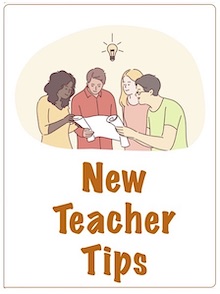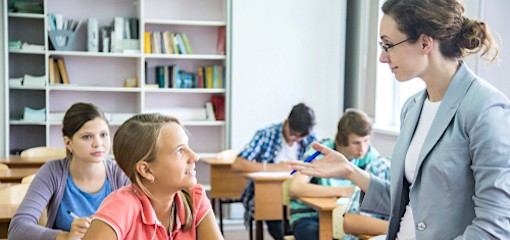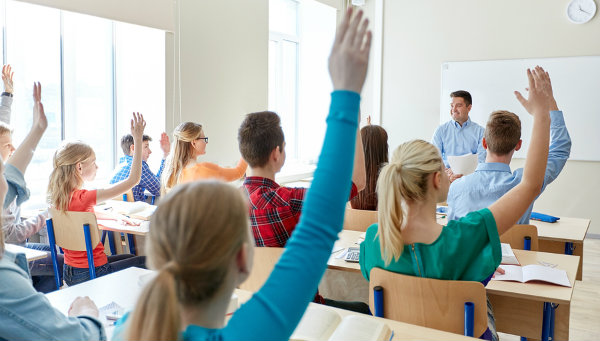2 Crucial 1st Steps Will Fuel Student Success
A MiddleWeb Blog

We decided one of the receptions would be held at our house. The idea made sense at the time. We have a large, landscaped yard, plenty of parking, and would save a bit of money that would have been spent renting a venue. As the date grew nearer, however, my wife and I found ourselves increasingly stressed and struggling with preparations for the big day.
Lucky for us, we had a few friends who’d recently survived their own children’s weddings. They graciously offered to help us chart out and sequence nearly everything that needed to be done. Doing so helped us prioritize which details needed to be tackled first. Both receptions ended up being a tremendous success.
As summer continues to evaporate, education blogs are abuzz with tips for getting teachers and students off to a perfect start this school year. It’s a worthwhile topic. As we prepare, however, it’s important for each of us to put first things first and focus on two crucial elements most likely to fuel student success in months that follow.
1. Teacher-Student Relationships
Perhaps the single most important ingredient in promoting positive youth development is teacher-student relationships. At the middle school level, positive relationships with adults impact students’ academic achievement, affect, behavior, and motivation, and a number of other factors we worry about in schools (Brinkworth, et al., 2018).
Effective teacher-student relationships are NOT contingent on how cool or likable each of us is. Teachers of various personality types can build effective relationships with students by…
1. Having an in-depth knowledge of students. Educators are better equipped to serve kids that we know, appreciate, and understand. Whether we are administering a get-know-you-survey in our classrooms or familiarizing ourselves with students another way, the sooner we know…and know about each student, the better.
Knowledge of learners, however, goes beyond proper pronunciation of kids’ names and familiarity with the interests, conceptions, and preconceptions that they bring with them about the topics we’ll be teaching. It’s equally important that we know how each individual approaches and troubleshoots various learning tasks.
2. Conveying high expectations and a desire to help students be successful. Educators who communicate high, yet achievable academic and behavioral standards to students make it clear that they hope for – and have confidence in – each individual’s ability to set and successfully attain goals.
3. Utilizing feedback effectively. Effective feedback should be frequent, focused, and timely. In addition, students should have an opportunity to provide their own feedback to the teacher. For example, see this survey that I regularly administer to my students.
4. Helping students feel sufficiently supported. Interestingly, research indicates that students’ perception of teacher support matters just as much as the actual aid rendered by the teacher (Chong et al., 2018). That’s why it’s important to communicate in words and actions that we are accessible, ready, and willing to work with our students to help them overcome challenges and barriers to learning.
2. Don’t Be Mean; Be Clear
One question I often hear from novice teachers is… How do I walk the line between being strict and still approachable with my students? I often answer that it isn’t about being mean…it’s about being clear.
In the classroom, teacher clarity is the degree to which teachers effectively provide instruction and communicate behavioral/academic expectations (Fisher et al., 2018). Talk to any veteran teacher and they will likely stress the importance of establishing clear expectations and procedures in the opening days and weeks of school. Doing so reduces both teacher and student frustration resulting from different perceptions of acceptable behavior.
Classroom expectations, or rules, should be few in number, specific, clear, and easily understood by everyone in the classroom. They should also be phrased positively in terms of the desired behavior, rather than a bunch of DON’T’s. For example, instead of a statement… Don’t touch other students or their gear… we could have an expectation that says… We keep our hands, feet, and the rest of our bodies to ourselves.
In addition, authorship leads to greater accountability and ownership. Whether a teacher works with students to develop/refine class expectations (or simply asks for a bit of feedback), students are more likely to adhere to – and help enforce – rules they feel they have contributed to.
Above all, teachers should model exactly what desired behaviors look like, allow students opportunities to practice, and encourage questioning and discussion about the classroom expectations regularly throughout the semester or school year.
Conclusion
In the thick of preparing for my oldest child’s dual receptions, I stumbled upon a valuable lesson that’s pertinent to our work as educators.
With so many to-do’s, it’s easy for us to get lost and overwhelmed. Educators starting the school year must recognize that effective teaching and learning occur when we prioritize our preparation. Build strong teacher-student relationships and establish classroom clarity first.
References
Alter, P., & Haydon, T. (2017). Characteristics of effective classroom rules: A review of the literature. Teacher Education and Special Education, 40(2), 114-127.
Brinkworth, M. E., McIntyre, J., Juraschek, A. D., & Gehlbach, H. (2018). Teacher-student relationships: The positives and negatives of assessing both perspectives. Journal of Applied Developmental Psychology, 55, 24-38.
Chong, W. H., Liem, G. A. D., Huan, V. S., Kit, P. L., & Ang, R. P. (2018). Student perceptions of self-efficacy and teacher support for learning in fostering youth competencies: Roles of affective and cognitive engagement. Journal of adolescence, 68, 1-11.
Fisher, D., & Frey, N. (2022). Are You Communicating High Expectations? Educational Leadership, 79(6), 74-75.
Fisher, D., Frey, N., Amador, O., & Assof, J. (2018). The teacher clarity playbook: A hands-on guide to creating learning intentions and success criteria for organized, effective instruction. Corwin Press.
Hill, H. C., & Chin, M. (2018). Connections between teachers’ knowledge of students, instruction, and achievement outcomes. American Educational Research Journal, 55(5), 1076-1112.
Kim, L. E., Dar-Nimrod, I., & MacCann, C. (2018). Teacher personality and teacher effectiveness in secondary school: Personality predicts teacher support and student self-efficacy but not academic achievement. Journal of educational psychology, 110(3), 309.



































